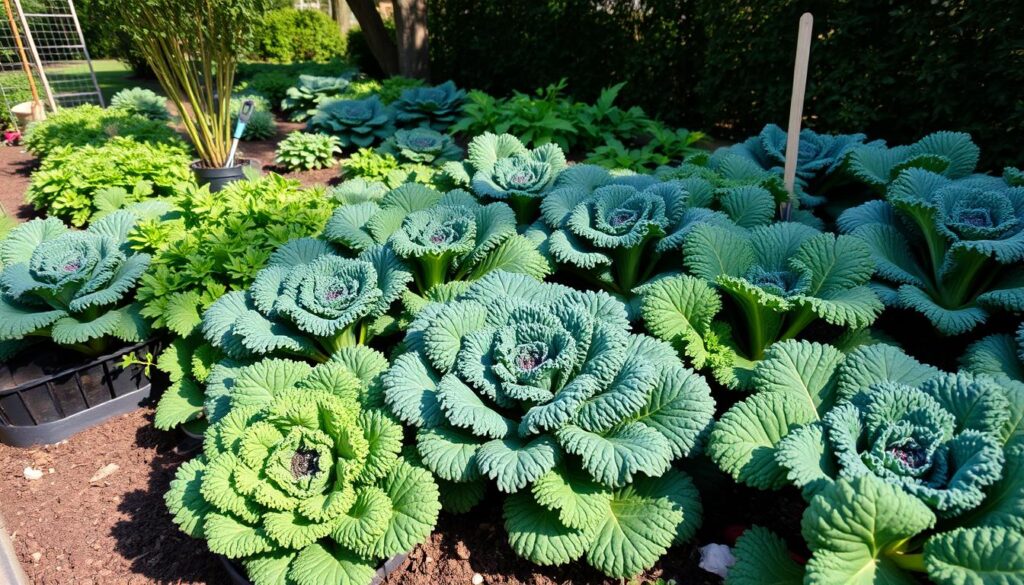Kale is a nutritious and versatile vegetable that grows well in many conditions. It’s perfect for gardeners of all levels. To grow kale successfully, choose the right variety and provide the best growing conditions. With the right techniques, anyone can enjoy a bountiful harvest of delicious and healthy kale.
Learning to grow kale is easier than you think. With the right tips, you can have a successful harvest. Follow the tips in this article to become a kale gardening expert and enjoy the benefits of growing your own kale.
This guide is for both seasoned and new gardeners. It covers the essential steps and tips for growing kale. From selecting the right variety to harvesting and maintaining your kale plants, you’ll learn it all. With these tips, you’ll enjoy a bountiful harvest of delicious and healthy kale all year round.
Introduction to Kale Gardening
Growing kale is rewarding and enjoyable. With the right knowledge and techniques, anyone can master kale gardening. Follow the tips and guidelines in this article to grow delicious and healthy kale and enjoy the benefits of kale gardening.
Key Takeaways
- Learn how to grow kale with easy-to-follow tips and guidelines
- Discover the best practices for growing kale, including selecting the right variety and providing optimal growing conditions
- Master the art of kale gardening and enjoy a bountiful harvest of delicious and healthy kale
- Get the most out of your kale plants with expert advice on harvesting and maintaining
- Enjoy the many benefits of kale gardening, including fresh air, exercise, and a sense of accomplishment
- Grow kale all year round with the right techniques and knowledge
Understanding Different Kale Varieties
Kale is a versatile and nutritious vegetable with many shapes, sizes, and flavors. To grow kale well, knowing the different types is key. A good guide should cover the various kale types, their growth habits, and needs. By following the right planting steps, you can pick the best kale for your garden and climate.
Popular kale varieties include curly kale, lacinato (dinosaur) kale, and red Russian kale. Each has its own benefits and drawbacks. For instance, curly kale is loved for its tender leaves and mild taste. Lacinato kale is prized for its nutty flavor and unique texture.
- Curly kale: tender and curly leaves, mild flavor, and high yields
- Lacinato (dinosaur) kale: nutty flavor, distinctive texture, and slow-bolting tendency
- Red Russian kale: flat and fringed leaves, sweet and slightly bitter flavor, and cold hardiness
By considering these points and using a reliable guide, you can choose the best kale for your garden. Remember to plant it correctly for the best growth and taste.
Essential Growing Requirements for Kale
To grow kale from seed, knowing the key growing needs is vital. Kale thrives in the right temperature, light, water, and soil. The best temperature for kale is 60-70°F (15-21°C). It also needs 4-6 hours of light daily.
Soil conditions are also important. Kale grows best in soil with a pH of 6.0-7.0. It needs consistent moisture, about 1-2 inches of water a week. Here are some key factors to consider:
- Temperature: 60-70°F (15-21°C)
- Light: 4-6 hours per day
- Water: 1-2 inches per week
- Soil pH: 6.0-7.0
By following these tips, you can create the perfect environment for your kale. Keep an eye on your plants and adjust their care as needed. This will help them grow healthy and strong.
With the right care, you can enjoy a lot of delicious kale. Whether you’re new to gardening or have experience, growing kale from seed is rewarding. By meeting these essential needs and following these tips, you’ll grow healthy kale plants.
| Factor | Ideal Condition |
|---|---|
| Temperature | 60-70°F (15-21°C) |
| Light | 4-6 hours per day |
| Water | 1-2 inches per week |
| Soil pH | 6.0-7.0 |
Selecting the Perfect Location for Your Kale Garden
Choosing the right spot for your kale is key to a great harvest. Use kale maintenance techniques and kale planting instructions to help. A good location can greatly improve your kale garden’s health and yield.
First, check how much sunlight your garden gets. Most kale needs 4-6 hours of direct sun daily. For more on container gardening, visit container gardening guides for tips.
Sunlight Requirements
Kale loves cooler weather, between 60-70°F (15-21°C). If your garden gets full sun, add shade for the hottest part of the day. This prevents the plants from bolting.
Soil Conditions
Kale grows best in well-draining, fertile soil with a pH of 6.0-7.0. Test your soil to see its pH and nutrient levels. If needed, adjust it to create the best environment for your kale.
Space Considerations
When planting kale, leave enough space for air and growth. Plant them 12-18 inches apart. Follow these tips and use the right kale planting instructions for a healthy kale garden.
How to Grow Kale from Seeds
Growing kale from seed can be very rewarding. With the right steps, you can have a lot of kale to enjoy. A good guide will help you from starting the soil to caring for the seedlings.
Indoor Seed Starting Methods
To start kale seeds indoors, you need the right setup. Use a quality seed starting mix and keep the soil warm. A heating mat or a warm spot can help with this.
Direct Sowing Techniques
Direct sowing is another way to grow kale. This means planting seeds straight into the garden. Make sure the spot gets full sun and has good drainage.
Proper Seed Spacing
Spacing seeds correctly is key. Plant them 2-3 inches apart and 1/4 inch deep. When they grow, thin them to 6-8 inches apart.
By following these tips and using a good guide, you can grow kale from seed. You’ll enjoy its health benefits and delicious taste.
| Method | Advantages | Disadvantages |
|---|---|---|
| Indoor Seed Starting | Allows for earlier start, better control over conditions | Requires more equipment, can be more expensive |
| Direct Sowing | Less expensive, easier to manage | Can be more challenging, dependent on weather conditions |
Preparing Your Soil for Kale Plants
Soil preparation is key for growing kale. It needs well-draining soil rich in organic matter. To get this, add compost or well-rotted manure to your soil. Kale grows best in a soil pH between 6.0 and 7.0.
Here are some tips to prepare your soil for kale plants:
- Test your soil to determine its pH level and nutrient content
- Add organic matter such as compost or well-rotted manure to improve soil structure and fertility
- Remove any debris or weeds that can compete with your kale plants for water and nutrients
By following these tips, you can make your soil fertile and well-draining. This will help your kale plants grow healthy.
| Soil Type | pH Level | Nutrient Content |
|---|---|---|
| Clay | 6.0-7.0 | High in nutrients, but prone to waterlogging |
| Sandy | 6.0-7.0 | Low in nutrients, but well-draining |
| Loam | 6.0-7.0 | Balance of nutrients and good drainage |
Transplanting Kale Seedlings Successfully
Transplanting kale seedlings is a key step in growing kale. A good guide will tell you about timing, depth, and spacing. These are important for a smooth transition.
First, harden off your seedlings before moving them outside. This step helps them adjust to outdoor life without shock.
Timing Your Transplant
Transplant when your seedlings have 2-3 sets of leaves. This is about 1-2 weeks after they sprout.
Proper Planting Depth
Plant the seedlings at the same depth as in their trays. This avoids stem rot and other problems.
Spacing Guidelines
Space kale seedlings 12-18 inches apart. This ensures they get enough air and don’t crowd each other.
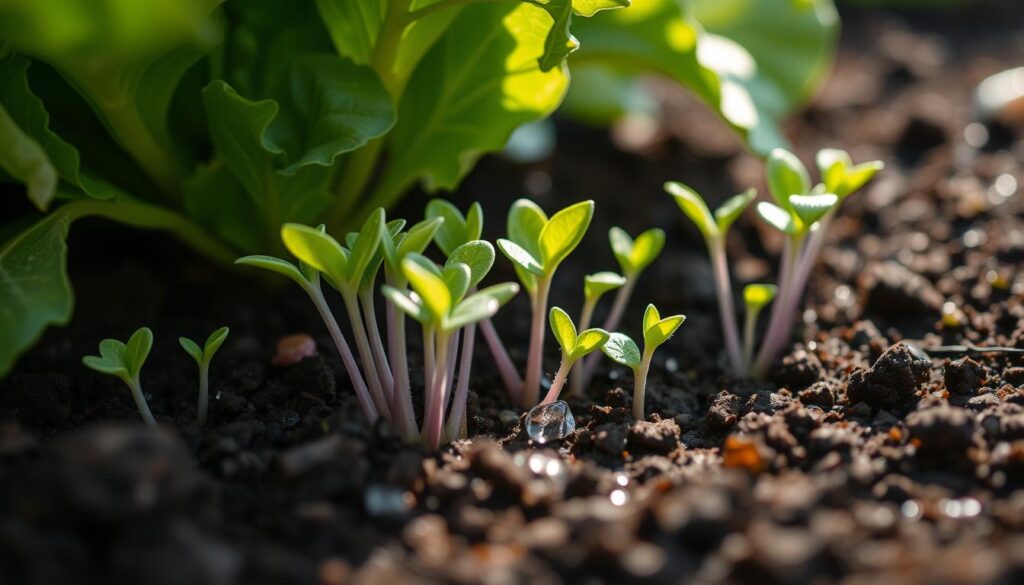
By following these tips, you’ll grow healthy kale plants. These instructions and guidelines will help a lot.
| Transplanting Tips | Benefits |
|---|---|
| Harden off seedlings | Prevents shock and promotes healthy growth |
| Plant at correct depth | Prevents stem rot and promotes strong stem growth |
| Space seedlings correctly | Promotes good air circulation and prevents overcrowding |
Essential Watering Techniques
Proper watering is key for healthy kale growth. Kale care tips stress the need for consistent moisture. Kale needs about 1-2 inches of water weekly, from rain or irrigation.
It’s vital to avoid overwatering. This can cause root rot and other issues.
To water your kale right, try these kale maintenance techniques:
- Water your kale deeply once or twice a week, based on the weather.
- Use mulch to keep moisture in and control soil temperature.
- Check soil moisture by feeling it with your finger up to the knuckle.
By following these tips, you can give your kale the right water. This helps them grow well. Keep the soil moist but not too wet.
With good watering and kale maintenance techniques, you’ll get a lot of tasty kale.
| Kale Variety | Watering Requirements |
|---|---|
| Curly Kale | 1-2 inches per week |
| Lacinato (Dinosaur) Kale | 1-2 inches per week |
| Red Russian Kale | 1-2 inches per week |
Fertilizing Your Kale Plants
Fertilizing is key for kale to grow well and produce lots. A good guide should talk about the best ways to fertilize. Knowing how to use fertilizers helps your kale plants grow strong.
A balanced fertilizer gives kale plants the nutrients they need. Organic fertilizer options are great because they’re good for the environment and the soil. You can use compost, manure, or fish emulsion as organic fertilizers.
Organic Fertilizer Options
- Compost: rich in nutrients and improves soil structure
- Manure: high in nitrogen and phosphorus
- Fish emulsion: balanced fertilizer with nitrogen, phosphorus, and potassium
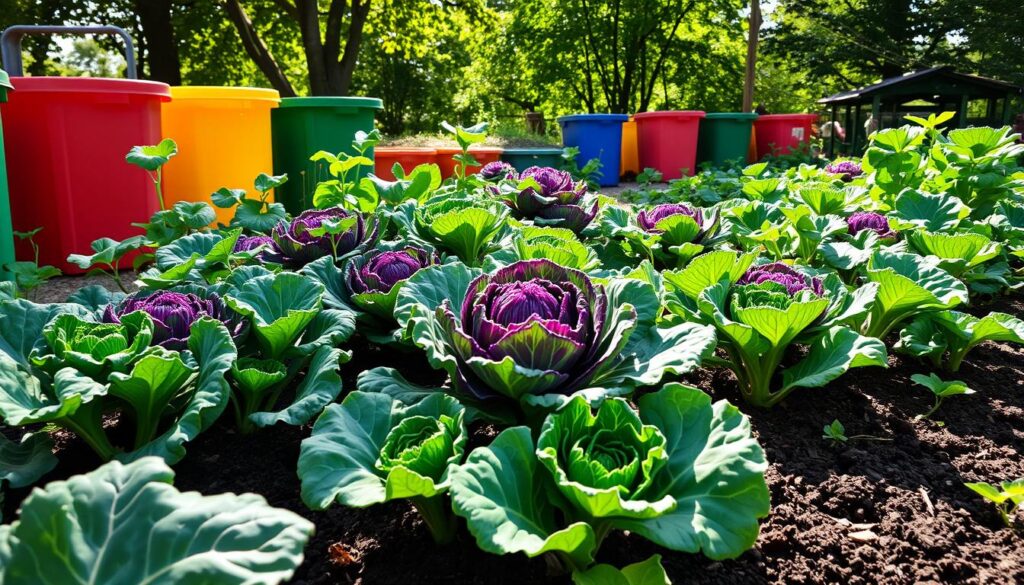
Application Timeline
When to apply fertilizer depends on the kale’s growth stage. A guide should say to fertilize at planting and again when plants are 6 inches tall.
Nutrient Requirements
Kale needs a mix of nitrogen, phosphorus, and potassium to grow well. A guide should explain what nutrients kale needs and how to give them the right amount.
| Nutrient | Role in Kale Growth |
|---|---|
| Nitrogen | Promotes leaf growth and development |
| Phosphorus | Supports root development and flower formation |
| Potassium | Helps with overall plant health and resistance to disease |
Managing Pests and Diseases
To keep your kale plants healthy, it’s key to use kale care tips and kale maintenance techniques. Managing pests and diseases is a big part of kale gardening. Common pests include aphids, whiteflies, and caterpillars. Regular checks and organic controls like neem oil can stop infestations.
Some important kale care tips for pests and diseases are:
- Using row covers to keep pests away
- Practicing good hygiene and removing sick plants
- Encouraging beneficial insects like ladybugs and lacewings
By using these kale maintenance techniques, you can lower the risk of pests and diseases. This way, you can enjoy a healthy and productive kale harvest.
Remember, a well-maintained kale garden needs regular care. With the right kale care tips and kale maintenance techniques, you can grow delicious and nutritious kale all season.
| Pest/Disease | Control Method |
|---|---|
| Aphids | Neem oil, insecticidal soap |
| Whiteflies | Yellow sticky traps, insecticidal soap |
| Caterpillars | Bt (Bacillus thuringiensis), hand-picking |
Companion Planting with Kale
Companion planting is key for growing kale well. It helps improve growth and keeps pests and diseases away. By planting different plants together, you create a balanced garden. This is important for kale to grow healthy and avoid common problems.
To start, pick the right plants to go with your kale. Marigolds repel nematodes, and basil makes kale taste better and keeps pests away. Garlic and chives also help because they fight off bacteria.
Beneficial Companions
- Marigolds: repel nematodes and attract beneficial insects
- Basil: improves flavor and repels pests
- Garlic: has natural antibacterial properties
- Chives: repel aphids and other pests
But, there are plants you shouldn’t grow with kale. Members of the Brassica family, like broccoli and cauliflower, get sick easily with kale. By picking the right plants to grow together, you can make your garden healthy and strong.
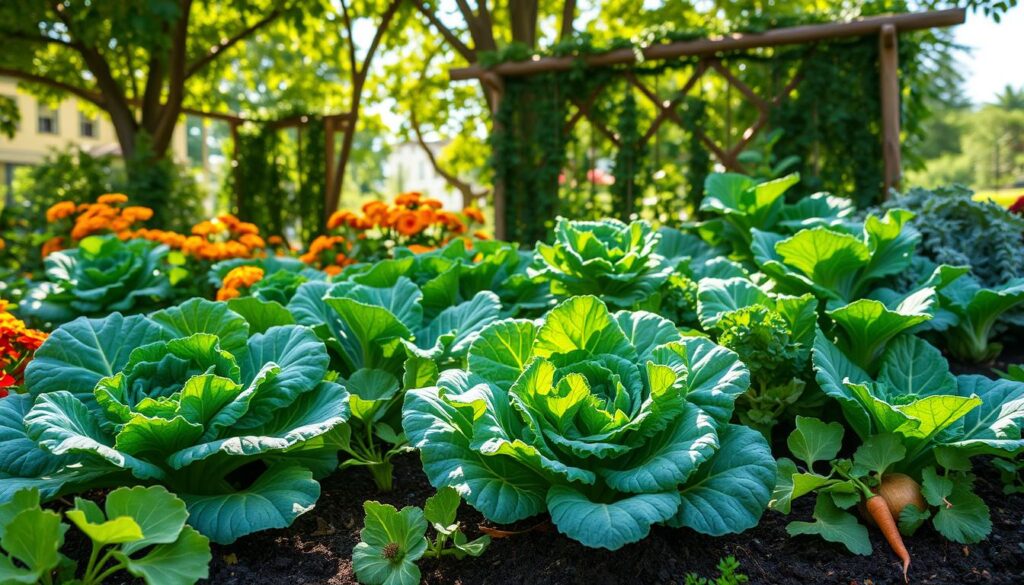
Seasonal Care Tips for Kale
Kale grows best in cool weather. Its care changes with the seasons. In spring, protect it from frost and heavy rain.
In summer, give it enough water and nutrients. Watch out for pests and diseases. In fall, harvest the kale and prepare the soil for next year.
For winter, mulch the soil to keep it moist and protect the plants from cold. These tips help you grow kale all year round.
- Provide adequate sunlight and water
- Use organic fertilizers to promote healthy growth
- Keep an eye out for pests and diseases
Kale is a versatile and nutritious crop that can be grown year-round with the right care and attention. By following these seasonal care tips and maintenance techniques, you can enjoy a continuous harvest of delicious and healthy kale.
Harvesting Your Kale
Harvesting kale is key in kale gardening. Knowing when and how to harvest is vital. It ensures you get the most from your kale. A good kale cultivation guide will teach you these important steps.
When to Harvest
Kale is ready to pick in 50 to 70 days, depending on the type. Check if the leaves are tender and taste good. Harvesting at the right time is key for the best flavor and texture.
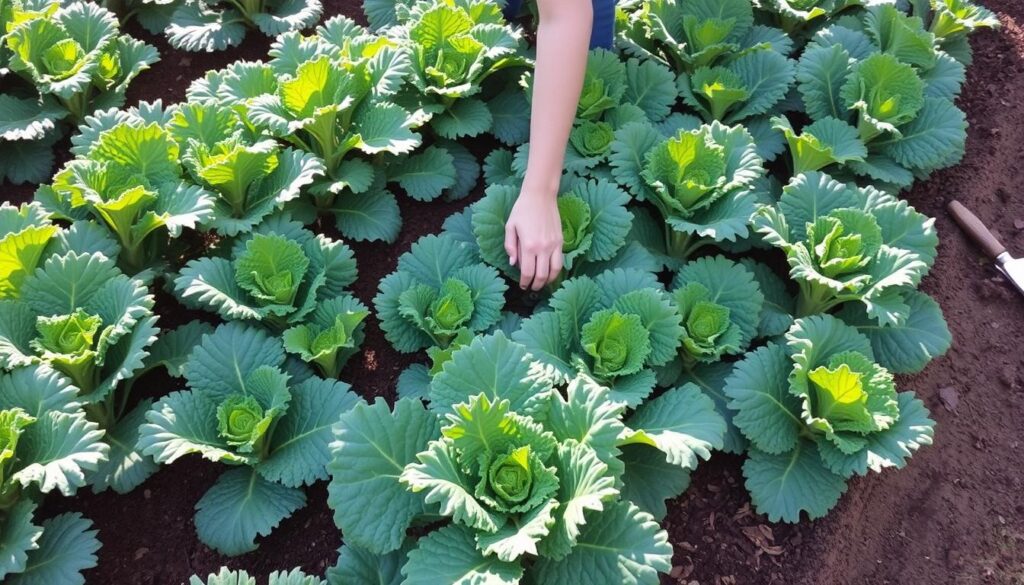
Proper Cutting Techniques
Use a sharp knife or scissors to cut the leaves from the plant. Cut at the base of the stem, leaving an inch for regrowth. This method is a must in any kale cultivation guide.
Storage Methods
Store your kale in a cool, dry spot to keep it fresh. You can put it in an airtight container in the fridge or freeze it. Proper storage helps keep your kale’s nutritional value and taste, as a detailed harvesting kale guide will show.
Extending Your Growing Season
To enjoy kale all year, you need to extend your growing season. There are many kale care tips and kale maintenance techniques to help. You can use row covers or cold frames to create a microclimate. These protect your kale from bad weather, letting it grow even when it’s not the right time.
Indoor growing is another way to keep kale going all year. Move your kale plants to pots and put them in a sunny spot inside. With the right kale care tips, like enough light and the right temperature, you can have fresh kale all year. Important things for indoor growing include:
- Enough light, from the sun or artificial sources
- A steady temperature of 60-70°F
- Regular watering and fertilizing
By using these kale maintenance techniques, you can grow kale all year. Whether you use row covers, cold frames, or indoor growing, the goal is to give your kale the best conditions.
With a bit of creativity and the right kale care tips, you can have plenty of fresh kale, even when it’s not the right season. So, why not try it and see how it changes your kale gardening?
| Kale Variety | Optimal Growing Conditions | Harvest Time |
|---|---|---|
| Curly Kale | Full sun, well-draining soil | 50-60 days |
| Lacinato (Dinosaur) Kale | Partial shade, moist soil | 60-70 days |
| Red Russian Kale | Full sun, fertile soil | 50-60 days |
Common Kale Growing Challenges
Kale gardening can be rewarding but comes with challenges. You might face issues like bolting, pests, and diseases. To grow a healthy garden, it’s key to know how to prevent and control these problems. By following the right planting steps, you can avoid these issues and enjoy a great harvest.
Some common issues that kale gardeners face include:
- Bolting: This happens when kale plants produce flowers and seeds, cutting down on leaf production. To stop bolting, keep your kale moist and avoid extreme weather.
- Pests: Aphids, slugs, and caterpillars can harm kale leaves. Use organic pest control, like neem oil or picking them off by hand, to fight infestations.
- Diseases: Kale can get fungal diseases like powdery mildew and downy mildew. Keep your garden clean, remove sick leaves, and use fungicides if needed.
Knowing these challenges and how to prevent them can help your kale garden thrive. Always check a good kale cultivation guide and follow the planting instructions for a successful harvest.
With the right knowledge and methods, you can beat common kale growing challenges. Whether you’re new to gardening or experienced, a well-planned kale garden can give you a steady supply of healthy, tasty kale.
| Challenge | Prevention/Control |
|---|---|
| Bolting | Consistent moisture, avoid extreme temperatures |
| Pests | Organic pest control methods, such as neem oil or hand-picking |
| Diseases | Good hygiene, remove infected leaves, treat with fungicides if necessary |
Tips for Growing Kale in Containers
Growing kale in containers is a great way to enjoy this nutritious vegetable in small spaces. To start, choose the right container, soil, and fertilizer. Kale care tips suggest picking a container that’s at least 6-8 inches deep for root growth.
For soil, a well-draining potting mix is best. Kale maintenance techniques also mean fertilizing regularly with a balanced fertilizer high in nitrogen. Here are more tips:
- Use a container with good drainage holes to prevent waterlogged soil
- Keep the soil consistently moist, but not waterlogged
- Provide your kale plants with plenty of sunlight, at least 4-6 hours a day
By following these kale care tips and kale maintenance techniques, you can enjoy a bountiful harvest of delicious and nutritious kale from your container garden.
Conclusion: Growing Your Own Nutritious Kale Year-Round
Growing your own kale year-round is very rewarding. It needs careful planning and execution. By following the kale growing tips and best practices for growing kale in this guide, you can become a pro at kale gardening. You’ll enjoy a rich harvest all year.
For a thriving kale garden, know the unique traits of different kale types. Also, provide the right growing conditions and care. With dedication and some green-thumbed skills, you can grow this superfood in your backyard or patio.
So, enjoy growing your own kale. Savor the fresh, tasty harvests that will nourish you and your family. Happy gardening!
FAQ
What are the different types of kale varieties?
There are several kale varieties, like curly kale, lacinato (dinosaur) kale, and red Russian kale. Each has its own look, growth pattern, and needs.
What are the essential growing requirements for kale?
Kale needs cool temperatures, full sun, and well-draining soil. It also needs consistent moisture. Knowing these needs is key to growing kale well.
How do I select the perfect location for my kale garden?
Look for a spot with at least 6 hours of sunlight a day. The soil should be well-draining and rich in nutrients. Make sure there’s enough space too.
How do I grow kale from seeds?
You can start kale seeds indoors or directly in the garden. It’s important to space the seeds right, prepare the soil well, and care for the seedlings.
How do I transplant kale seedlings successfully?
Choose the right time to transplant and plant at the correct depth. Space the seedlings well. Hardening off the seedlings before transplanting helps them adjust.
How do I properly water and fertilize my kale plants?
Keep the soil moist and fertilize regularly. Use organic fertilizers and follow the recommended schedule and amounts.
How do I manage pests and diseases in my kale garden?
Use row covers, companion planting, and organic pest controls to manage pests and diseases. This approach helps prevent and control problems.
When and how do I harvest my kale?
Harvest kale at different stages, from individual leaves to the whole plant. Cut correctly and store properly to keep your kale fresh and tasty.
How can I extend my kale growing season?
Use row covers, cold frames, and indoor growing to grow kale all year. This is great for areas with cold winters.
What are some common kale growing challenges and how can I address them?
Challenges include bolting, pests, and diseases. To overcome these, maintain good growing conditions and use integrated pest management.
Share this post: on Twitter on Facebook

